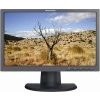- Qualcomm Launches Snapdragon 4 Gen 2 Mobile Platform
- AMD Launches Ryzen PRO 7000 Series Mobile & Desktop Platform
- Intel Launches Sleek Single-Slot Arc Pro A60 Workstation Graphics Card
- NVIDIA Announces Latest Ada Lovelace Additions: GeForce RTX 4060 Ti & RTX 4060
- Maxon Redshift With AMD Radeon GPU Rendering Support Now Available
Lenovo L220X 22″ Widescreen LCD Monitor

Lenovo tests the waters in the LCD market with a product that we’ve been waiting quite some time for — a 22" LCD monitor that offers a 1920 x 1200 native resolution. But is its resolution alone enough reason for you to give it the nod?
Page 4 – Benchmarks
We’ve chosen DisplayMate for Windows, well known for its industry-standard testing capabilities and calibration options, to do the bulk of our benchmarking for our display reviews, because it offers an enormous amount of tools and testing patterns to help insure accurate results, no matter the type or quality of the display.
We also used tests from www.tft.vanity.dk because their tests can be effectively used across different platforms, and offer their tools free for anyone to use. We encourage readers to take the time, if interested, to see how their display performs using these tests.
Our benchmarks will test the following categories:
- Manufacturing defects (Dead/stuck pixels, etc.)
- Color accuracy
- Contrast ratio
- Backlight quality
- Viewing angles and color uniformity
- Ghosting and response times
- Input lag
In the future, we will incorporate calibration tools to measure Delta E values (the difference between requested color values from the computer and the values represented on the display) as a hallmark for our accuracy benchmarks. In the meantime, we will continue to use "by eye" tests to compare displays, as we still feel this method to be accurate enough to justify a consumer-made decision.
Fortunately, we had no dead or stuck pixels with our review unit. There were no issues with the build quality with the monitor itself, or the panel being used. What we received would be considered a "perfect" display from the retailer. We regret to say other manufacturers have been known to provide poor quality control, which has become long apparent, even in our reviews. Lenovo has long catered to business users, who demand reliable products, so our luck gives us assurance of Lenovo’s quality standards.
I found the monitor’s color output to be very accurate, even without any calibration. Out of the box, colors were well represented in the desktop, in movies, and in games to the point where changing the picture settings could almost be discouraged. Similarly, there were no problems with banding, gradients looked as smooth as they should be, unlike other panels that have trouble displaying a true blend between colors.
Simply put, the contrast ratio was superb. Being an S-PVA panel, the difference in quality from this monitor truly shows compared to a TN panel you would find on any other display the same size. As a result, it also doesn’t include a dynamic contrast ratio feature, which would normally adjust the color on the screen depending on the viewing mode selected to achieve much higher, exaggerated numbers, so the difference between white and black remains constant all the time.
Lenovo did a fantastic job with their back-lighting on this display. Within the first two weeks of using it, I thought the display looked totally uniform on black, a first for me with a CCFL-back-lit monitor. But I eventually noticed that the four corners were slightly lighter than the center of the display. That said, the L220X was by far the best performing display I’ve seen with back light uniformity.
Being an S-PVA panel, there was a noticeable amount of color shifting present. In the first test image, the word "QUALITY" is visible when viewed head-on. However, when viewing the image to the side, the image changes, revealing detail.
In the second test image, the background should appear black, including the black box in the lower-left corner (although some detail in the background is acceptable). If you’re monitor has a color shifting problem, like the L220X, viewing the screen at a different horizontal angle should further reveal color, as well as the previously-hidden box.
The problems with the shifting are inherent, and there is only so much that can be done about it with simple calibration. While it isn’t as noticeable as a TN panel, the problem is there and should be accounted for if any serious video or photography work is going to be done with it especially. Sadly, the only way to prevent it is to opt for a higher-quality IPS panel, which means eliminating every 22" monitor on the market and a lot of larger screens as well. The monitor’s overall viewing angles were in line with other MVA panels, making it still a fine choice for gaming or office work.
As I mentioned in the gaming tests, no ghosting was readily visible. Our trailing tests uncovered some visible trailing, but it was nothing alarming enough to lead us to avoid our recommendation to gamers. The input lag test between the L220X and Dell 2007WFP revealed that the monitor had a lag of 9 milliseconds, easily within acceptable range, in my opinion.
Read ahead for my final thoughts.
Support our efforts! With ad revenue at an all-time low for written websites, we're relying more than ever on reader support to help us continue putting so much effort into this type of content. You can support us by becoming a Patron, or by using our Amazon shopping affiliate links listed through our articles. Thanks for your support!








